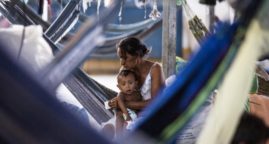Children bear ‘disproportionate lethal impact’ of Syrian war, warns study
Article published on The Guardian website on 12/07/2017 by Karen McVeigh
Questions raised over legality of airstrikes and shelling as figures show a quarter of all civilians killed in Syria in 2016 were under 18
Child deaths are on the rise in Syria’s war, according to estimates that show one in four civilians killed in 2016 was under the age of 18.
The authors of a study published in the Lancet Global Health said aerial bombing in urban areas had “a disproportionate lethal impact on civilians, particularly children”.
Civilians accounted for 71% of the 143,630 deaths in the first six years of the Syrian war, noted the study, while 29% were opposition fighters.
The report, based on conflict-related deaths recorded by the Violations Documentation Center (VDC), followed recent calls for UN member states to conduct an urgent review of military rules of engagement after a record number of civilians were killed by explosive weapons last year.
Over the course of the conflict, the proportion of child civilian casualties increased from 9% of 4,354 deaths in 2011 to 23% of 11,444 civilian deaths in 2016. The rise stemmed from “increased reliance on aerial bombing by the Syrian government and international partners”, found the researchers.
Professor Debarati Guha-Sapir of the University of Louvain’s public health health faculty, the study’s lead author, said: “Our findings underscore the highly limited efficacy of shelling and aerial bombing against opposition fighters, and the disproportionate lethal impact on civilians, particularly children.
“These findings call into question the use of these weapons in populated urban areas and suggest possible indiscriminate weapons use contrary to international humanitarian law.”
A total of 57% of civilian deaths were caused by airstrikes and shelling, compared with 10% of opposition fighters, the study found. But while male civilian deaths were caused equally by airstrikes, shells, shootings and executions, women and children were mostly killed by shells and airstrikes. The impact increased as the use of these weapons grew from 2014, when international parties intensified the aerial bombing of Syria, the report said.
Of 11,444 civilian deaths in Syria recorded in 2016, 2,662 were children, and 1,582 were women, the study found. The war has displaced more than half of the Syrian population and, as of 2014, reduced life expectancy by up to 20 years, according to the Syrian Centre for Policy Research.
The impact on civilians of barrel bombs – improvised, fragmenting explosives filled with shrapnel, nails or further explosives – was striking, the study noted. Civilians accounted for about 97% of barrel bomb deaths, “suggesting indiscriminate or targeted warfare … possibly constituting a war crime”, said the researchers.
In Syria, barrel bombs have been dropped on hospitals, markets, and homes, with “double tap” strikes used in an attempt to eliminate first responders and medical services. Earlier this year, the Lancet published a report by its Commission on Syria highlighting how healthcare was being used as a weapon of war in the country.
Husam Alkatlaby, the executive director of the VDC, said documenting Syria’s dead was important but heartbreaking work that was becoming increasingly difficult.
“There are a large number of victims,” Alkatlaby said. “It is not easy to collect the data, but it is important for any transitional justice process. We believe we cannot reach any peace agreement in Syria without a transitional justice process. But the problem is, people have lost hope. After seven years, they do not believe in an international justice system.
“Syrian people are saying to us, ‘Everybody in the world knows we are dying every day, but nobody is doing anything to save our dying children.’”
Guha-Sapir said the impact of barrel bombs on civilians supports claims that the weapons have been used to directly target them.
“Approximately three-quarters of recorded incidents of explosive weapon use in Syria have occurred in densely populated civilian areas, putting civilians at very high risk and suggesting a degree of intentionality,” she said.
A quarter of all documented barrel bomb deaths were children
Difficulties of access and the nature of the impact meant the number of deaths caused by wide-area explosives was likely to be an underestimate, said the report’s authors. The study did not include deaths caused indirectly by war, such as increased disease or medical shortages, or fatalities among those who had been detained or had disappeared.
Guhu-Sapir said the international community had to share responsibility for the deaths: “They have to face the consequences that the bombing deaths have much more impact on civilians and an increasing proportion of children. This is against the laws of war.”
Based on the provinces VDC staff were able to enter, up to late 2012 the greatest number of civilian deaths occurred in Homs. Thereafter, the highest figures were in Aleppo and Damascus, which accounted for 25% of all deaths as well as the highest number of children killed by shelling. Aleppo saw 40% of child deaths by airstrikes.
Data from government controlled areas, which are unsafe for VDC staff to enter, was not included in the study.
The US-led coalition battling Islamic State has claimed its strikes in Syria and Iraq have killed 800 civilians since the campaign began in 2014, far fewer than those documented by monitoring and human rights groups.
The Syrian Network for Human Rights has put the total number of children killed in the Syrian war from March 2011 to November 2017 at 26,446. Drawing on a network of sources as well as survivor accounts, the UK-based organisation estimates that 81% died in attacks by Syrian government forces. Russian forces were calculated to be behind 5.8% of child deaths, with armed opposition factions accounting for 3.5%, extremist Islamist groups 3%, and international coalition forces 2.7%.
Airwars, the monitoring group, estimated US-led coalition air and artillery strikes are likely to have killed between 828 and 1,062 children since September 2014.
Related Articles
AB Gallagher on Holy See’s action to protect Christians and other minorities
05/22/2017. The Holy See’s ‘foreign minister’, Archbishop Paul Gallagher full statement
Worldwide displacement tops 70 million, UN Refugee Chief urges greater solidarity in response
06/19/2019. This is the highest level that UNHCR, the UN Refugee Agency, has seen in its almost 70 years.
Vatican official: Europe not immune to anti-Christian discrimination
03/31/2017.Archbishop Paul Richard Gallagher called on an “institutionalized dialogue” at all levels between civil authorities and religious groups to help foster religious liberty.





